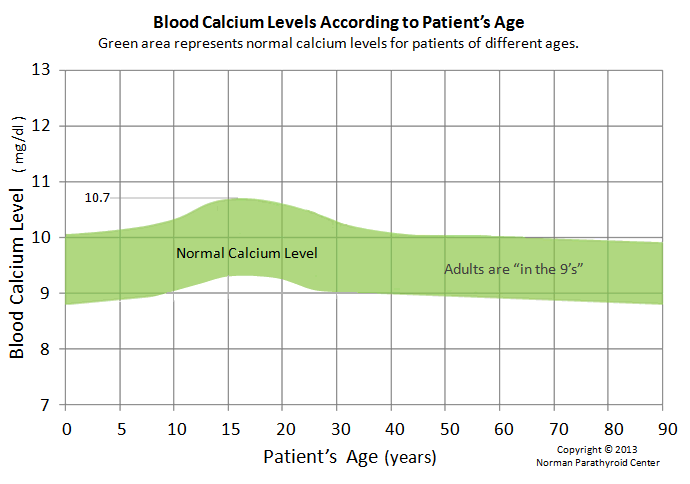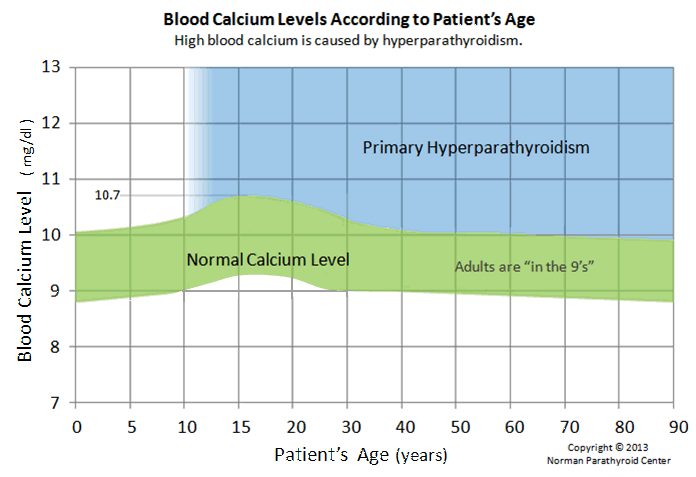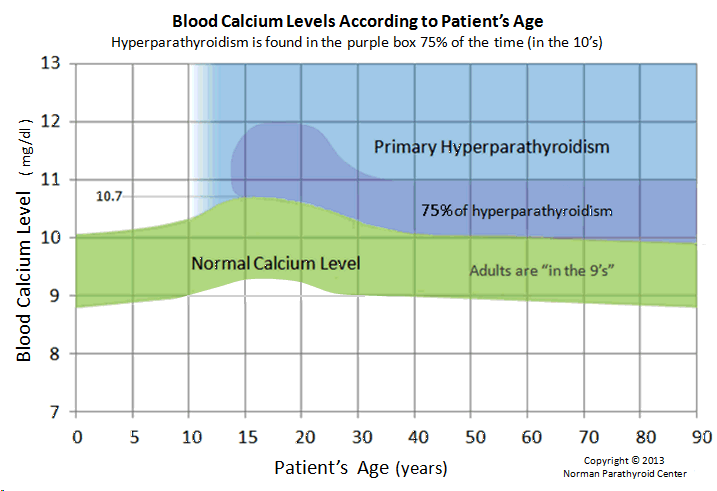What is the Normal Range for Calcium in the Blood?
Blood calcium levels are different depending on your age with children, teenagers and young adults having higher levels of calcium than adults over age 30 or 35. The role of the parathyroid glands is to maintain blood calcium levels in a normal range. This small normal range for blood calcium is different for different ages as shown on the graph below. The green area on this graph shows how the normal range for blood calcium changes as we go through life. The bottom X axis is our age in years, and the vertical Y axis is the amount of calcium in the blood. Note how the blood calcium increases quite dramatically when we are teenagers and growing bone (and getting taller). At age 26 our bones are the strongest and most dense (have the most calcium in them), and from that point on, the hormone changes in our bodies causes the amount of calcium in our blood to decrease. By the time we are 35 we should have most of our calcium levels below 10.2 mg/dl. Once we are over 40, we should not have calcium levels above 10.0 or 10.1. Almost all people over 40 have calcium levels "in the 9's". If you are in Europe and Canada, the high limit of normal calcium is 2.5 mmol/l.

Here is the BIG PROBLEM...
Most laboratories that measure your blood calcium do NOT correct for your age, or they have calcium ranges that are too large.
One of the most common mistakes we see while evaluating thousands of patients every year for hyperparathyroidism and high blood calcium, is that doctors are not aware that the lab is not giving a "normal range" according to that patient's age. Instead, the lab will often give a normal range for "all humans" and that normal range will go up to 10.5 or even 10.7 mg/dl. Well technically the lab is correct, this is the range for all humans, but if the patient is 55 years old, then the upper limit of normal on that patient's labs should be 10.0 mg/dl. The lab is not giving a normal blood calcium range for YOU, it is giving a normal range for all humans of all ages.
We see patients over 40 years old every day who have had blood calcium levels over 10.0 mg/dl for years, but they think this is normal because the lab says it is normal to have calcium up to 10.6. This is not correct! Blood calcium levels of 10.2 to 10.5 in a person over 40 indicates a parathyroid tumor until proven otherwise.
Hypercalcemia Calculator: Calculate the Upper Limit of Blood Calcium for your Age
Enter your age and our calculator will give the upper limit of normal calcium for you.
The Upper Limit of Calcium for your age is [Enter Your Age Above] mg/dl in the USA, and [Enter Your Age Above] mmol/L in most other countries. Calcium levels above this should be considered too high for your age.
The upper limit of calcium varies with age with teenagers having the highest levels and adults over 50 having the lowest. Unfortunately, most labs don't give the upper limit of normal according to your age, so we have made this calculator for you. Note that blood calcium is measured differently in different parts of the world. Just as we measure distance in feet and miles in the USA, while other countries use meters and kilometers; in the USA we measure calcium with the units mg/dl while most other countries use the units mmol/L. The units your lab uses will be printed right next to your results.Blood calcium levels above the normal range will cause problems.
This next graph goes one step further and shows very clearly that patients with hyperparathyroidism have high blood calcium, which is shown in blue. Note that diagnosing a person with hyperparathyroidism who is 18 years old is very different from diagnosing a person who is 65 years old. A normal, healthy teenager will have blood calcium levels that are above 10.0, and most of the time these healthy normal teenagers have calcium levels between 10.0 and 10.7 mg/dl. A patient who is 60 years old, however, should have calcium levels "in the 9's". A calcium level of 10.5 is normal in a person who is 21 years old, but signals the presence of a parathyroid tumor in an adult over 40 years old.

Teenagers with hyperparathyroidism typically have blood calcium levels between 10.9 and 12.3 - it isn't subtle. For adults over 40 years old, however, frequent or persistent calcium levels above 10.2 almost always indicate a parathyroid tumor. One point here... the blue area starts around age 10 because hyperparathyroidism is so rare below age 10 that it essentially doesn't exist. Remember, people of any age above 10 can get a parathyroid tumor, but the peak incidence is between the ages of 50 and 80. See our page on age for more about this. (Note: about 2% of people with hyperparathyroidism can have calcium levels in the green area, not "all" patients with hyperparathyroidism have high blood calcium).
Most adults with hyperparathyroidism have blood calcium levels that are only a little elevated.
The third and final graph in this series shows that 75% of people with primary hyperparathyroidism (and thus have a parathyroid tumor in their neck) have blood calcium levels that are just modestly elevated. Other pages of this website have different graphs that show average blood calcium and PTH for our last 20,000 patients, but here we can easily show that most parathyroid tumors increase the calcium in your blood only modestly which is shown by the purple area. Thus, most adults with hyperparathyroidism have calcium levels "in the 10's". Remember, adults over 40 or so should have calcium levels "in the 9's".

Now you see the biggest challenge we face... most people with a parathyroid tumor have only slightly or modestly elevated calcium levels and the lab is not giving normal ranges specific to the patient's age. Every day we see patients with parathyroid tumors who have never had a calcium level that was "out of range" - because the range given was incorrect.
The height of the blood calcium is a very poor indicator of the severity of hyperparathyroidism
In many areas of life, and many areas in medicine for that matter, a higher number is more significant than a lower number. A cholesterol of 350 is "worse" than a cholesterol of 310, for instance. Blood calcium levels are the big exception to this rule. The person with the "worse" hyperparathyroidism is the one who has had high blood calcium the LONGEST, not the one with the HIGHEST calcium.
This is why we do not recommend "watching" or "monitoring" your slightly high calcium to see if it goes any higher. First, how high it is doesn't matter! A "slightly" high calcium for a number of years can cause severe health problems (discussed in great detail elsewhere). Second, we know what happens when parathyroid disease goes untreated. The calcium level may never get into the "extremely high" range, but over time the risk of complications from the disease (including osteoporosis, kidney stones, kidney disease, cardiac arrhythmias, chronic fatigue, memory loss, insomnia, and more) rises. How high the calcium has become is a very poor indicator of the severity of primary hyperparathyroidism.
A blood calcium of 11.5 is NOT more dangerous than a blood calcium of 10.5.
In summary, normal calcium levels vary with age. Your body wants to keep your calcium in a tight range, and the parathyroid glands are responsible for that. For teenagers and young adults, it is normal to have calcium levels up into the mid to high 10's (in mg/dl). For adults over about age 40, the calcium level should generally be in the 9.3 to 9.9 mg/dl range. High calcium levels almost always indicate parathyroid disease.
What to read next
- If you have high calcium, then you should download the CalciumPro app. Let the computer tell you what is wrong.
- If you want to read more about calcium levels in the blood, how to diagnose parathyroid disease, and look at a graph of normal and high calcium levels, then go to our page on Diagnosing Parathyroid Disease.
- The best page of this website describes the video of Dr Norman performing a complete parathyroid operation, removing two parathyroid tumors--all in less than 13 minutes.
- Dr Norman gives a 6-minute video on hyperparathyroidism.
- How to become our patient
This page was last updated: 04/12/2021




